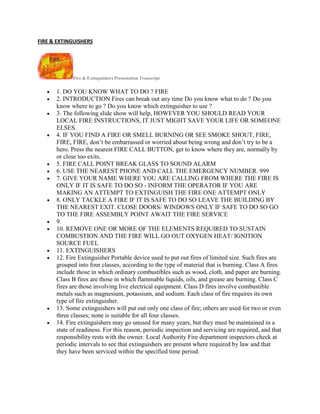
Fire & extinguishers
- 1. FIRE & EXTINGUISHERS Fire & Extinguishers Presentation Transcript 1. DO YOU KNOW WHAT TO DO ? FIRE 2. INTRODUCTION Fires can break out any time Do you know what to do ? Do you know where to go ? Do you know which extinguisher to use ? 3. The following slide show will help, HOWEVER YOU SHOULD READ YOUR LOCAL FIRE INSTRUCTIONS, IT JUST MIGHT SAVE YOUR LIFE OR SOMEONE ELSES. 4. IF YOU FIND A FIRE OR SMELL BURNING OR SEE SMOKE SHOUT, FIRE, FIRE, FIRE, don’t be embarrassed or worried about being wrong and don’t try to be a hero. Press the nearest FIRE CALL BUTTON, get to know where they are, normally by or close too exits. 5. FIRE CALL POINT BREAK GLASS TO SOUND ALARM 6. USE THE NEAREST PHONE AND CALL THE EMERGENCY NUMBER. 999 7. GIVE YOUR NAME WHERE YOU ARE CALLING FROM WHERE THE FIRE IS ONLY IF IT IS SAFE TO DO SO - INFORM THE OPERATOR IF YOU ARE MAKING AN ATTEMPT TO EXTINGUISH THE FIRE ONE ATTEMPT ONLY 8. ONLY TACKLE A FIRE IF IT IS SAFE TO DO SO LEAVE THE BUILDING BY THE NEAREST EXIT. CLOSE DOORS/ WINDOWS ONLY IF SAFE TO DO SO GO TO THE FIRE ASSEMBLY POINT AWAIT THE FIRE SERVICE 9. 10. REMOVE ONE OR MORE OF THE ELEMENTS REQUIRED TO SUSTAIN COMBUSTION AND THE FIRE WILL GO OUT OXYGEN HEAT/ IGNITION SOURCE FUEL 11. EXTINGUISHERS 12. Fire Extinguisher Portable device used to put out fires of limited size. Such fires are grouped into four classes, according to the type of material that is burning. Class A fires include those in which ordinary combustibles such as wood, cloth, and paper are burning. Class B fires are those in which flammable liquids, oils, and grease are burning. Class C fires are those involving live electrical equipment. Class D fires involve combustible metals such as magnesium, potassium, and sodium. Each class of fire requires its own type of fire extinguisher. 13. Some extinguishers will put out only one class of fire; others are used for two or even three classes; none is suitable for all four classes. 14. Fire extinguishers may go unused for many years, but they must be maintained in a state of readiness. For this reason, periodic inspection and servicing are required, and that responsibility rests with the owner. Local Authority Fire department inspectors check at periodic intervals to see that extinguishers are present where required by law and that they have been serviced within the specified time period.
- 2. 15. Class A fire extinguishers Class A fire extinguishers are usually water based. Water provides a heat-absorbing (cooling) effect on the burning material to extinguish the fire. Stored-pressure extinguishers use air under pressure to expel water. 16. EXTINGUISHERS FOR CLASS B FIRES Class B fires are put out by excluding air, by slowing down the release of flammable vapours , or by interrupting the chain reaction of the combustion. Three types of extinguishing agents — carbon dioxide gas, dry chemical (powder) , and foam are used for fires involving flammable liquids, liquefiable solids, greases, and oils. 17. Carbon dioxide is a compressed gas agent that prevents combustion by displacing the oxygen in the air surrounding the fire. (CAUTION, DO NOT TOUCH THE HORN OR BASE OF THE EXTINGUISHER DURING DISCHARGE AS THEY BECOME EXTREMELY COLD) 18. The two types of dry chemical extinguishers include one that contains ordinary sodium or potassium bicarbonate, urea potassium bicarbonate, and potassium chloride base agents; The multi-purpose, dry chemical type extinguishers contains an ammonium phosphate based powder. The multi-purpose extinguisher can be used on class A, B, and C fires. 19. Most dry chemical extinguishers use stored pressure to discharge the agent, and the fire is extinguished mainly by the interruption of the combustion chain reaction. 20. Foam extinguishers use an aqueous film forming foam (AFFF) agent that expels a layer of foam when it is discharged through a nozzle. It acts as a barrier to exclude oxygen from the fire 21. EXTINGUISHERS FOR CLASS C FIRES The extinguishing agent in a class C fire extinguisher must be electrically non-conductive. Both carbon dioxide and dry chemicals can be used in electrical fires. An advantage of carbon dioxide is that it leaves no residue after the fire is extinguished. When electrical equipment is not energized, extinguishers for class A or B fires may be used. 22. EXTINGUISHERS FOR CLASS D FIRES A heat-absorbing extinguishing medium is needed for fires in combustible metals. Also, the extinguishing medium must not react with the burning metal. The extinguishing agents, known as dry powders, cover the burning metal and provide a smothering blanket. 23. The extinguisher label gives operating instructions and identifies the class, or classes, of fire on which the extinguisher may be used safely. USING THE WRONG EXTINGUISHER CAN BE DANGEROUS The extinguisher label 24. Under EC directives all new extinguishers are coloured RED a coloured band will identify the type of extinguisher, READ THE INSTRUCTIONS New extinguishers WATER FOAM POWDER CO2 WATER FOAM AFFF POWDER CO2 25. OLD STYLE COLOURED EXTINGUISHERS WATER FOAM AFFF POWDER CO2 26. THE END Don’t let it be yours